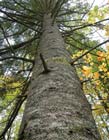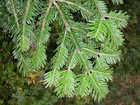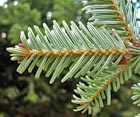Conservation Status

Abies alba
Miller 1759
Common names
European or common silver fir (Silba 1986), abeto (Spanish).
Taxonomic notes
Syn. A. pardei Gaussen (Silba 1986).
Description
Trees up to 55 m tall and 260 cm DBH, with a long clear bole and a pyramidal crown that becomes flat-topped with age. Bark smooth, gray, scaly, with resin blisters. Twigs grooved, pale brown or dull gray with a blackish pubescence. Shade foliage 2-ranked, spreading horizontally; foliage in sun more or less erect. Needle base twisted, apex notched or rounded; 15-30 × 1.5-2 mm; upper surface dark shiny green and grooved, usually lacking stomata; lower surface glaucous to whitish-green, keeled, with stomata in 5-8 ranks. Buds pale brown to reddish-brown, ovoid with an obtuse apex, sometimes resinous, diameter 8-11 mm, slightly pubescent. Pollen cones blue/violet/red, 1-3 cm long. Seed cones cylindrical, attenuate at the ends, 10-16 × 3-5 cm, green when young, turning red-brown; cone scales spathulate, finely pubescent with exserted, reflexed bracts extending about 2/3 the length of the scale. Seeds obovoid, reddish, winged, up to 2.5 cm long (Silba 1986). See García Esteban et al. (2004) for a detailed characterization of the wood anatomy.
Distribution and Ecology
France; Italy; Switzerland; Germany; Austria; Bulgaria; Ukraine: Karpaty Mts.; Byelorussia; at 300-1950 m elevation (Silba 1986, Vladimir Dinets e-mail 1998.01.02); Croatia. Hardy to Zone 4 (cold hardiness limit between -34.3°C and -28.9°C) (Bannister and Neuner 2001).
Distribution of Abies in the Mediterranean region. Data from Conifers of the World BRAHMS database, downloaded 2017.11.05. Taxa are color coded; see pull-out menu at left of map for details. Click on each occurrence for further information.
Remarkable Specimens
Currently the largest known living single-stem tree is "Doria GTF", a tree discovered in 2018 in Biogradska Gora National Park, Montenegro. At 59.71 m tall (tape drop) and 713 cm girth (227 cm DBH), it is both the largest and tallest specimen of living Abies alba now known (Giant Trees Foundation 2019), and the largest and tallest tree in Montenegro. It may also be the largest forest-grown tree in Europe, with a volume of approximately 75 to 80 m3 (Kouta Räsänen email 2019.10.22, who also visited the tree and confirmed its measurements). Further details and photos of the tree are posted at Monumental Trees.
Here are some other reported large trees:
- Height 56.1 m (laser, sine method), DBH 129.5 cm, in Dobroč National Nature Reserve, Slovakia (Räsänen 2015).
- Height 53.3 m, DBH 219 cm, wood volume of 50 m3 (in 2013), the "Great Fir of the Waldhaus" in Germany (Monumental Trees 2013).
- Height 68 m, DBH 380 cm, wood volume of 140 m3 in the Black Forest of Germany (historical record) (Botany.cz, accessed 2009.05.02). Accuracy of height measurement uncertain.
- Height 45 m, DBH 296 cm, at Strone House, Strathclyde, Great Britain (Mitchell et al. 1990).
- Height 50 m, DBH 206, at Raehills, Dumfries & Galloway, Great Britain. The height measurement is from before 1990 and is thus uncertain; the girth was measured last in 2001 (Mitchell et al. 1990 and Monumental Trees).
- Height 50 m, DBH 207 cm, wood volume of 65.3 m3. This was the famous Prince Joseph's Silver Fir in the Bohemian Forest near the city "Vyšší Brod." It died about 1839 (Botany.cz, accessed 2009.05.02); accuracy of height measurement uncertain.
The oldest known trees is in the Jura Mountains of Switzerland, and had a crossdated age of 475 years when sampled ca. 1993 (Brown 2023). Another age record is provided by a tree-ring chronology covering 411 years, presumably based on living tree material, that was collected in 1952 in Bayerischer Wald, Germany (48.75°N, 13.00°E) by B. Becker (Data accessed at the NOAA Paleoclimatology Program Tree-Ring Data Search
Page, 1999.02.24, a href="http://julius.ngdc.noaa.gov/paleo/ftp-treering.html, now defunct).
Ethnobotany
Foliar loppings of European silver fir in Czechoslovakia have yielded 1,380 tonnes/year of essential oils (Cermak and Penka 1979).
Rolland (1993) did an exploratory study to evaluate the species' utility in dendrochronology; the Bibliography of Dendrochronology provides some 290 additional citations.
This species has been used to produce one of the most unusual conifer products I have heard of: fir leaf wool. An anonymous blurb in the 1885 Bulletin of the Torrey Botanical Club says "Fir Leaf Wool is a textile fibre which in Saxony is manufactured out of the needles of the fir-tree, the process being partly chemical and partly mechanical. For this purpose the needles are gathered in spring and summer, when they are young and green, old and withered ones being unsuitable. They are taken into barns, and there dried in a current of air. When dried, they are subjected to a settling and fermenting process similar to that in use for flax. This softens the woody parts and loosens them from the fibre, but the complete separation is only obtained after a lengthy boiling by steam. During this boiling a by-product is obtained in the shape of an oil (fir-wood oil), which is gathered and sold to chemists as a remedy for rheumatism and gout, its properties being similar to those of turpentine. The complete separation of bast and fibre is produced exactly as with flax. The fibre is now passed through a milling machine similar to that in use for woolen cloth, and is then carded and spun like cotton. Generally the carded fibre is mixed with a certain proportion of cotton or wool, and thus a kind of merino yarn is produced, which is worked in the hosiery frames into singlets, dravyers, and stockings, these fabrics being then sold as anti-rheumatics and as a preventive of gout. When examined under the microscope the fibre appears as a tube, and striped, and as if covered by a fine network. Goods made of this fibre are sold to a considerable extent in Germany, though they are dearer than the ordinary merino goods."
Observations
Räsänen (email 2019.10.22) suggests "Perućica Forest Reserve in Sutjeska National Park, Bosnia and Herzegovina. This old-growth forest reserve (14 km2) is perhaps the most heavily dominated by Abies alba of all the forests I have seen, with many large individuals. There is a hiking trail through the forest. Montenegro's Biogradska Gora National Park (16 km2 of old-growth forest) is also a representative forest with a lot of large Abies alba and hiking trails."
Remarks
Genetic, pollen and macrofossil evidence shows that Abies alba spent the last glacial maximum in at least three central European refugia: one in the northern Apennines, one in the southern Balkans, and one in the northern or western Balkans. The genetic data also indicate that a similar pattern likely occurred earlier in the Quaternary, with multiple episodes of genetic isolation and introgression (Lipelt et al. 2009).
Citations
Brown, Peter. 2023. OLDLIST, A Database Of Old Trees. http://www.rmtrr.org/oldlist.htm, accessed 2023.10.31.
Cermak, J. and M. Penka. 1979. An attempt to estimate potential production of volatile terpenes from the logging by-products of silver fir (Abies alba Mill.). Planta Medica 36:3, 252.
Giant Trees Foundation. 2019. Doria GTF. gianttrees.org/it/alberi-giganti/doria-gtf, accessed 2019.10.24.
Liepelt, Sascha, Ronald Bialozyt, and Birgit Ziegenhagen. 2002. Wind-dispersed pollen mediates postglacial gene flow among refugia. Proceedings of the National Academy of Sciences 99(22):14590-14594.
Liepelt, S., R. Cheddadi, J. L. de Beaulieu, B. Fady, D. Gömöry, E. Hussendörfer, M. Konnert, T. Litt, R. Longauer, R. Terhürne-Berson, and B. Ziegenhagen. 2009. Postglacial range expansion and its genetic imprints in Abies alba (Mill.) — a synthesis from palaeobotanic and genetic data. Review of Palaeobotany and Palynology 153(1):139-149.
Miller, P. 1759. The Gardeners Dictionary, 7th edition. V.2, p.110.
Monumental Trees. 2013. European silver fir 'Große Waldhaustanne' in the street Hans-Watzlik-Hain. https://www.monumentaltrees.com/en/deu/bavaria/regen/6704_hanswatzlikhain/13605/, accessed 2017.09.04.
Räsänen, Kouta. 2015.10.08. Dobroč Primeval Forest – new record for European silver fir. www.ents-bbs.org/viewtopic.php?f=203&t=7276, accessed 2015.10.17.
Rolland, C. 1993. Tree-ring and climate relationships for Abies alba in the internal Alps. Tree-Ring Bulletin 53:1-11.
Stöber, Kurt. 1999. Images from Thomé, Flora von Deutschland etc. http://www.mpiz-koeln.mpg.de/~stueber/thome/index.html, accessed 2003.05.01, now defunct.
See also
Elwes and Henry 1906-1913 at the Biodiversity Heritage Library (as A. pectinata) (Photos). This series of volumes, privately printed, provides some of the most engaging descriptions of conifers ever published. Although they only treat species cultivated in the U.K. and Ireland, and the taxonomy is a bit dated, still these accounts are thorough, treating such topics as species description, range, varieties, exceptionally old or tall specimens, remarkable trees, and cultivation. Despite being over a century old, they are generally accurate, and are illustrated with some remarkable photographs and lithographs.
Photographs and species account at Botany.cz, accessed 2009.05.02.
Farjon, Aljos. 1990. Pinaceae: drawings and descriptions of the genera Abies, Cedrus, Pseudolarix, Keteleeria, Nothotsuga, Tsuga, Cathaya, Pseudotsuga, Larix and Picea. Königstein: Koeltz Scientific Books.
- Provides a detailed account, with illustrations.
Zeneli, G., M. Dida, F. Ducci, and D. Habili. 2004. Silver fir (Abies alba) resources in Albania and their conservation, in Forest Genetic Resources No. 31. www.fao.org/docrep/008/y5901e/Y5901E11.htm, accessed 2011.02.25.





